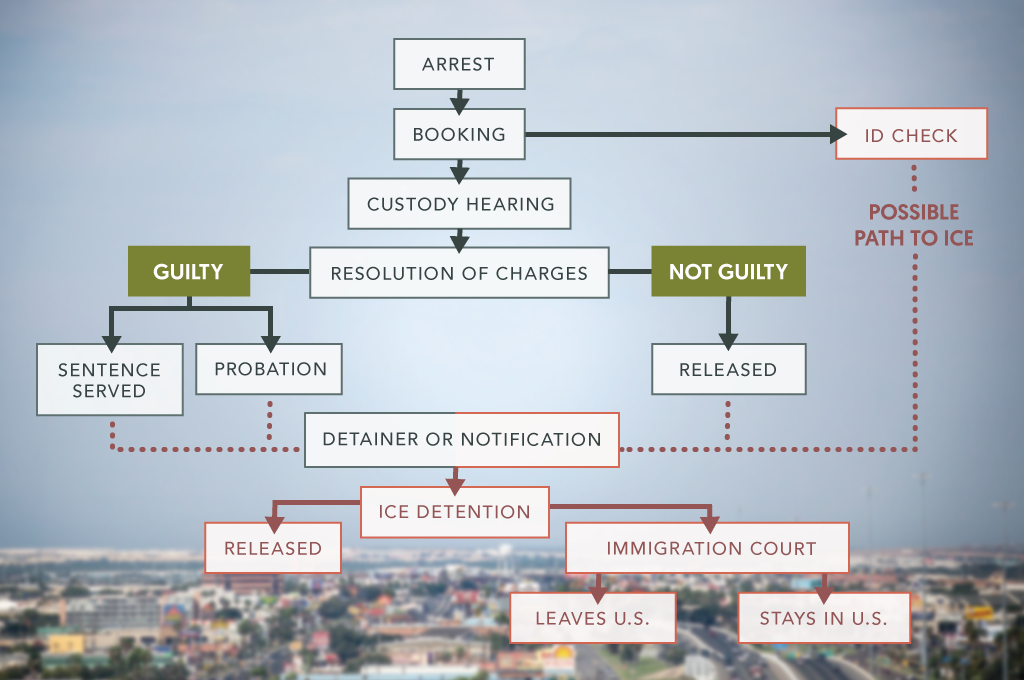
Enlarge
Photo by Martin do Nascimento
The badge of Captain Jaime Magaña in Webb County Jail in Laredo, TX, on Nov. 5, 2015. Photo by Martin do Nascimento
*Correction appended
With a $6 billion budget and more than 20,000 employees, U.S. Immigration and Customs Enforcement stands poised to seize and deport immigrants — undocumented or not — who commit serious crimes in the United States.
Provided someone else catches them.
The behemoth agency at the center of the nation’s immigration
enforcement efforts has no proactive way — watch lists, data mining or
the like — to systematically search for dangerous undocumented
immigrants, including those who have returned to the United States after
being deported for committing crimes.
Instead, if an immigrant criminal is caught and thrown out of the
country, the process most likely begins when a local police officer or
sheriff's deputy pulls them over for a traffic stop or arrests them as
part of a criminal investigation.
The success of federal deportation policy in Texas and nationwide
depends for the most part on a heads up from county sheriffs. They run
the jails where people are taken when arrested and where the culling of criminal immigrants begins.
Being at the bottom of the enforcement pyramid places tremendous
pressure on them — political, legal and otherwise — sheriffs say, and
with federal policy increasingly targeting serious, repeat criminal
offenders, their role in the process has grown.
“When some of these sheriffs talk about bringing in an undocumented,
it may be one a month,” said Dallas County Sheriff Lupe Valdez. “With
us, it’s several a day.”
The legal tool federal authorities use to take custody of immigrants they want is
the detainer.
Around in some form or fashion since the 1950s, detainers are notices
sent to jails asking them to hold on to an immigrant once local
authorities are done with them so federal agents can come by and get
them.
In its
latest incarnation,
the detainer is reserved for the most serious convicted immigrant
criminals. This new, narrower restriction, imposed in November 2014, has
caused the number of detainers
to drop. As of October 2015, the latest monthly figure available,
7,117 detainers were issued. That's down from an all-time monthly high of
27,755 in August 2011, according to voluminous Freedom of Information Act requests made by the
Transactional Records Access Clearinghouse at Syracuse University.
Texas is central to the federal agency’s deportation
efforts. Nationwide, only eight jails received more than 1,000 detainer
requests in the last year, according to clearinghouse data. Four were in
Texas — Harris, Travis, Dallas and Hidalgo counties.
A
report
last year on the federal agency’s enforcement operations shows it
plucked 139,368 people from the nation's jails and prisons during the
fiscal year ending Sept. 30, 2015. That accounted for about 59 percent
of the total number of people ICE removed from the country that year for
a variety of reasons.
Many came from Texas, screened out of state prisons or found among
the approximately 71,000 people who are booked into local Texas jails
each month, according to the Texas Department of Public Safety. On
average, 3,724 undocumented immigrants were detained in Texas jails each
month in 2015, according to a Texas Tribune analysis of immigration
detainer reports from the Texas Commission on Jail Standards.
Between December 2012 and October 2015, undocumented immigrants who
sat in Texas county jails cost taxpayers a total of $210.6 million,
according to reports filed with the Texas Commission on Jail Standards
that were released to The Texas Tribune.
In 2015, the federal government provided about $12 million
to Texas to care for incarcerated undocumented immigrants. Most of that
- more than $8 million - went to the Texas prison system, not jails.
Yet for all the statistics, no federal, state or local agency can
claim it has a handle on the number of "criminal aliens" — the
government's term for foreigners who commit crimes in the U.S. — who are
currently in the country, how many crimes they are responsible for and
what share the system catches.
Local options
In Harris, the state’s most populous county, 135,000 inmates each year come through the jailhouse doors. It and the city of Carrollton are the only two
Texas jurisdictions that contract with the federal government to have
immigration agents stationed at its jail helping pinpoint criminal
immigrants. Nine federal officers and nine Harris County deputies
schooled in federal procedures comb booking documents and interview
inmates suspected of being in the country illegally.

Enlargephoto by: Martin do Nascimento
A guard inside the Webb County Jail in Laredo, TX, on Nov. 5, 2015.
By contrast, in Brewster County, the state's geographically largest —
as in, bigger than some states — things work a bit differently. About
9,200 people live in the West Texas county, and its jail in Alpine has
no official policy for handling undocumented immigrants.
How does it strive to alert federal authorities when a criminal
immigrant is arrested? “We’ve got a sign on the wall,” jail
administrator Lora Nussbaum told the Tribune, referring to a torn ICE
flier taped on a jail wall that lists the agency's phone number.
County jails may be the front line of efforts to keep undocumented
immigrants who commit serious crimes from slipping through the cracks,
but the state of Texas has no uniform method of going about that task,
or measuring the scope of the problem.
To gain a better picture of crimes committed by undocumented
immigrants and how counties handle them, the Tribune asked for booking
data and immigration procedure policies from 26 Texas counties,
including the state’s 10 most populous.
Almost none would provide it. Some, like Montgomery and Presidio
counties, insisted that providing booking information, including an
inmate’s date of birth, violated the inmate’s right to privacy. Harris
County claimed that releasing a list of noncitizens was essentially
creating new information — something the Texas Public Information Act
does not require a governmental body to do.
Some counties argued that that federal law specifically prohibits releasing information about immigrants.
Attorney General
Ken Paxton's office upheld most of the counties’ arguments, saying state open records laws don't compel release of the information.
The Dallas County Sheriff’s Office went a step further and insisted
that booking records are court records and, as such, are not subject to
the state’s open records law. The attorney general’s office agreed,
blocking their release.
Five counties responded to the Tribune’s request for booking data:
Brewster, Nueces, Fort Bend, Travis and Tarrant. Of those, only Travis
responded with enough detailed information to analyze.
“We don’t want to be in a position where somebody loses their life because of something we didn’t do that was legal for us to do.”— Maj. Wes Priddy, chief administrator for Travis County jails
The numbers show that Travis County booked about 20,000 inmates with
federal immigration detainers between 2008 and 2015, facing charges that
were roughly evenly divided between felonies and misdemeanors. More
than 7,000 of those inmates faced drunk driving charges, the most common
charge by far. That was followed by family violence-related assault
charges, which about 1,900 inmates faced. An estimated 2,400 of the
total inmates were repeat offenders.
Maj. Wes Priddy, chief administrator for Travis County jails, said
local law enforcement’s primary concern was public safety, not
investigating immigration status. But he said that part of keeping
dangerous people off the streets involved close cooperation with federal
authorities.
“We don’t want to be in a position where somebody loses their life
because of something we didn’t do that was legal for us to do,” Priddy
said.
After arresting someone, the Department of Public Safety, county
sheriffs, and even the Texas Department of Criminal Justice — the
nation’s largest prison system — all have to rely on the federal
government to inform them who is in the United States illegally.
“What our obligation is, is to provide ICE with the population
information,” said Tarrant County Sheriff Dee Anderson. “They go through
it. They determine who they’re going to put a hold on and who they’re
not, and our people don’t really have a way to further investigate are
they truly here legally or not.”
That typically happens during the booking process, when a suspect’s
fingerprints are sent to the Federal Bureau of Investigation, a
procedure used for every new inmate. If the fingerprints match a profile
in the federal database of non-U.S. citizens with previous criminal
histories, ICE can decide to ask for a detainer. Texas jail officers do
ask arrestees to name their country of birth as a part of the booking
process, but an arrested immigrant’s answer is written down without
being verified.
The same holds true for inmates in Texas prison. As of Nov. 30, 2015,
three-fourths of the 9,135 inmates in the Texas prison system with ICE
detainers were in the United States illegally. The remainder include
those serving time for crimes who had legal immigration status.
“Ultimately, ICE will make the determination whether that person is
in country illegally,” said Texas prisons spokesman Jason Clark. In
2010, the agency began asking for ICE help verifying those among the
system’s 148,000 inmates who were illegally in the country.
But the federal tracking system of verifying what law enforcement
refers to as “criminal aliens” is less than precise. It relies on
someone's fingerprints being in the system because they have been
arrested before. If an undocumented immigrant has never encountered law
enforcement, the federal tracking system might not notice their first
arrest.
Jumbled numbers
There is no definitive data showing that undocumented immigrants
commit crimes at a higher rate than the citizen population, and a few
indications that in Texas they do not.
The Pew Research Center estimates undocumented immigrants comprise about seven percent of the Texas population. On average, 3,724 undocumented
immigrants were detained in Texas jails each month in 2015, according
to a Texas Tribune analysis of immigration detainer reports from the
Texas Commission on Jail Standards.
Of the 148,000 inmates held in 100 Texas prison units, about 9,135
inmates have federal detainers asking that they be handed to federal
officials when their sentences are complete. Not all were in the country
illegally when arrested. Those that were illegal account for about 4.6
percent of the prison population.
Nationwide, almost 60 percent of immigrants who are deported had some
previous criminal charges, according to 2015 numbers from ICE.

Enlargephoto by: Martin do Nascimento
A group of undocumented Mexican nationals who
were convicted of crimes in the U.S. enter Mexico at the US-Mexico
border crossing at Brownsville/Matamoros after being deported from the
United States on Nov 4, 2015.
The Pew Center, relying on 2012 U.S. Census numbers, estimated that
Texas has 1.7 million undocumented immigrants, ranking second in the
nation. What portion of that 1.7 million is responsible for crimes is a
tougher calculus.
Estimates from the Texas Department of Public Safety, which gets the
information from jails, are considered inaccurate because there’s no
uniform requirement to verify citizenship during the jail booking
process.
In 2014, then-Gov.
Rick Perry was
criticized for relying on DPS’ first attempts to calculate the impact
of crimes committed by immigrants. That year, Perry repeated the
department's claim that “criminal aliens” had committed more than
642,000 crimes in Texas since 2008. It was
later revealed
that “criminal aliens” referred to all foreign-born immigrants in
Texas, not just those in the state illegally, and the "crimes" counted
included charges, not convictions, some dating back decades.
One year later, DPS tried to clarify the numbers, but even director
Steve McCraw, appearing before the Texas House Committee on State
Affairs in December, tried to lower expectations about the “criminal
alien statistic” his agency featured on its website.
“It’s an undercount,” McCraw testified on Dec 10. “We acknowledge it
woefully undercounts the amount, but it does accurately count the ones
who are in fact here and the ones who have committed crimes.”
The DPS statistics continue to confuse both the public and lawmakers.
ICE officials consider a foreign national — here legally or otherwise
— a "criminal alien" if they've been convicted of a crime. DPS broadens
the definition to include foreign nationals who have only been
arrested.
“Criminal alien is a foreign national with a criminal record,"
explained DPS Assistant Director Skylor Hearn, who oversees the agency’s
law enforcement support division, which includes the state's crime
records. “There was probable cause to arrest them for something, and it
would apply to the rest of us as well, generally speaking. If you’ve
been arrested, you have a criminal record; you are not a criminal, but
you have a criminal record.”
By DPS's count, 177,060 foreign-born individuals were charged with
crimes from 2011 through Jan. 31. That's a much larger number than those
foreign nationals actually convicted during the same time frame in
Texas: 84,182 non-U.S. citizens. Of those, 58,128 were determined to be
in the United States unlawfully.
State Rep. Cesar Blanco, D-El Paso, says the DPS numbers on "criminal
aliens" are artificially pumped up by counting the number of criminal
charges filed against undocumented immigrants instead of actual
convictions. Charges are routinely dismissed for lack of evidence or
other reasons, he noted.
But by hyping the number of charges, the agency bolsters the argument
for more border security money. Last year, the Texas Legislature
approved an additional $800 million for border security.
"When crime rates were higher in this state, did the legislature move this much money?" Blanco asked.
Adding to the mathematical
murkiness, immigration status can be fluid. A foreign-born Texas jail
inmate could be legally in the country at the time of one arrest but
have an expired visa by the next arrest and be undocumented the second
time around, further bedeviling Texas’ attempts at measuring
unauthorized immigrants’ impact on the state’s criminal justice system.
Attempts by DPS to connect criminal aliens to their crimes also fall short.
The agency's data, obtained by the Tribune, shows that 177,060 non-U.S. citizens arrested from 2011 through Jan. 31 were charged with
252,083 offenses during that time. This is less than what DPS
reports on its own website because
the agency
counts crimes committed over a U.S. citizen's lifetime, outside the five-year span.
DPS officials insist that its
criminal alien counts, based on federal immigration data, are not an
attempt to construe that foreign-born criminals are a greater threat
than U.S. citizens.
“The department has not made that statement and does not have
information to support that statement,” DPS spokeswoman Summer Blackwell
said in a statement. “The Department of Public Safety believes any
individual who has committed a violent crime or is party to criminal
activities — no matter their citizenship status or country of origin —
is considered a potential threat to public safety and the security of
Texas.”



